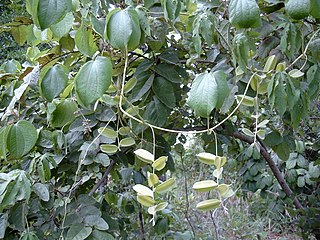
Dioscorea alata – also called ube, purple yam, or greater yam, among many other names – is a species of yam. The tubers are usually a vivid violet-purple to bright lavender in color, but some range in color from cream to plain white. It is sometimes confused with taro and the Okinawa sweet potato beniimo (紅芋), however D. alata is also grown in Okinawa. With its origins in the Asian tropics, D. alata has been known to humans since ancient times.

Dioscorea is a genus of over 600 species of flowering plants in the family Dioscoreaceae, native throughout the tropical and warm temperate regions of the world. The vast majority of the species are tropical, with only a few species extending into temperate climates. It was named by the monk Charles Plumier after the ancient Greek physician and botanist Dioscorides.

Dioscorea villosa is a species of twining tuberous vine which is native to eastern North America. It is commonly known as wild yam, colic root, rheumatism root, devil's bones, and fourleaf yam. It is common and widespread in a range stretching from Texas and Florida north to Minnesota, Ontario and Massachusetts.

Eddoe or eddo is a species in genus Colocasia, a tropical vegetable, closely related to taro, which is primarily used for its thickened stems (corms). In most cultivars there is an acrid taste that requires careful cooking. The young leaves can also be cooked and eaten, but they have a somewhat acrid taste.

Dichopogon strictus, commonly known as chocolate lily, is a herbaceous perennial plant species native to Australia.

Dioscorea communis or Tamus communis is a species of flowering plant in the yam family Dioscoreaceae and is commonly known as black bryony, lady's-seal or black bindweed.

Yam is the common name for some plant species in the genus Dioscorea that form edible tubers.

Dioscorea polystachya or Chinese yam, also called cinnamon-vine, is a species of flowering plant in the yam family. It is sometimes called Chinese potato or by its Korean name ma. It is also called huaishan in Mandarin and wàaih sāan in Cantonese.

Dioscorea oppositifolia is a type of yam (Dioscorea) native to Myanmar (Burma) and to the Indian Subcontinent.

Dioscorea bulbifera is a species of true yam in the yam family, Dioscoreaceae. It is native to Africa, Asia and northern Australia. It is widely cultivated and has become naturalized in many regions.

Carissa spinarum, the conkerberry or bush plum, is a large shrub of the dogbane family (Apocynaceae), widely distributed in tropical regions of Africa, Southern Asia, Australia, and various islands of the Indian Ocean. It is most well known in Australia, where it is also called currant bush or, more ambiguously, native currant or even black currant. It is, however, neither closely related to plums (Prunus) nor to true currants (Ribes), which belong to entirely different lineages of eudicots. In India, it is also called wild karanda/wild karavanda, referring to the related karanda. Carissa spinarum is often discussed under its many obsolete synonyms.

Geitonoplesium is a monotypic genus in the family Asphodelaceae, containing the sole species Geitonoplesium cymosum, commonly known as scrambling lily. The species is a perennial evergreen scrambling vine found in rainforests, sclerophyll forests and woodlands of eastern Australia, and parts of Malesia and Melanesia.

Eustrephus is a monotypic genus in the family Asparagaceae, subfamily Lomandroideae. The sole species is Eustrephus latifolius, commonly known as wombat berry. It is an evergreen vine native to Malesia, the Pacific Islands and eastern Australia. It grows in sclerophyll forest, woodland, heathlands, shrublands, gallery forest and rainforests.

Olea paniculata, commonly known as the native olive, is a plant of the genus Olea and a relative of the olive. It grows natively in Pakistan and southwestern China (Yunnan) through tropical Asia to Australia and the Pacific islands of New Caledonia, Vanuatu and Lord Howe Island.

Remusatia is a genus of flowering plants in the family Araceae. It contains 4 known species, one of which was described in 1987. This species was initially placed in genus Gonatanthus called Gonatanthus ornatus. After the genus had been sunk into Remusatia its new name was Remusatia ornatus, but it was later changed to Remusatia hookeriana.

Dioscorea pentaphylla is a species of flowering plant in the yam family known by the common name fiveleaf yam. It is native to southern and eastern Asia as well as New Guinea, Sri Lanka and northern Australia. It is widely cultivated as a food crop and naturalized in Cuba and on several island chains in the Pacific.

Dioscorea sansibarensis is a species of flowering plant in the yam family known by the common name Zanzibar yam. It is native to Madagascar and to tropical Africa from Tanzania west to Guinea and south to Mozambique, and it is known elsewhere as an introduced species.

Dioscorea dumetorum, also known as the bitter yam, cluster yam, trifoliate yam, or three-leaved yam, is a species of flowering plant in the yam family, Dioscorea. It is native to sub-Saharan Africa and especially common in the tropical regions of West Africa, including Nigeria, Benin, and Ghana. D. dumetorum has both toxic and non-toxic varieties.

Pterostylis hildae, commonly known as the rainforest greenhood, is a species of orchid found in eastern Australia. It has a rosette of leaves and when flowering a rosette at the base of a flowering stem with a single green, white and brown flower. It is found in wet forests, including rainforest in New South Wales and Queensland.

Dioscorea deltoidea, the Nepal yam, is a species of flowering plant in the family Dioscoreaceae. Its native range is the Himalayas through to south-central China and mainland Southeast Asia. Its tubers contain diosgenin and are harvested by local peoples as a treatment for a variety of conditions, including gastrointestinal disorders and intestinal worms. Tubers are also eaten after boiling, washing, and baking. It grows in forests and humus-rich soils.




















